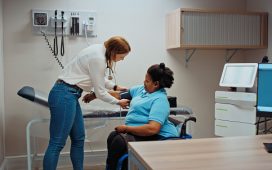The stethoscope, a symbol of the medical profession for centuries, has been a powerful tool for doctors to listen to the internal sounds of the human body. But in today’s rapidly advancing technological landscape, the stethoscope is just one piece of the puzzle. Enter wearable technology, a game-changing innovation that is reshaping the way we monitor patients’ health and transforming the healthcare experience.
Wearable devices, ranging from smartwatches and fitness trackers to specialized medical sensors, have become increasingly prevalent in recent years. These devices offer the ability to monitor vital signs, track physical activity, measure sleep patterns, and gather a wealth of data that was once only accessible in a clinical setting. This shift from intermittent office visits to continuous monitoring has the potential to revolutionize patient care in numerous ways.
One of the most significant impacts of wearable technology is the shift towards proactive healthcare. Traditional healthcare often relies on reactive measures—waiting for patients to exhibit symptoms before taking action. With wearable devices, we can detect subtle changes in health indicators early on, allowing for preventive interventions and timely medical attention. This proactive approach has the potential to prevent complications, reduce hospitalizations, and ultimately improve patient outcomes.
Chronic disease management is another area where wearables are making a profound difference. Conditions such as diabetes, hypertension, and cardiovascular disease require consistent monitoring and lifestyle management. Wearable devices empower individuals to take charge of their health by providing real-time data on blood glucose levels, blood pressure, heart rate, and more. This data can be shared with healthcare providers, enabling them to make informed decisions about treatment plans and adjustments.
For patients recovering from surgery or managing a chronic illness at home, wearable technology offers a level of convenience and peace of mind that was previously unthinkable. Continuous monitoring ensures that any concerning changes are detected early, allowing for timely medical intervention. This not only improves patient outcomes but also reduces the burden on healthcare facilities and caregivers.
The integration of wearable technology into telemedicine is a natural progression. Telemedicine has gained prominence, especially in recent times when remote access to healthcare has become crucial. Wearable devices provide a wealth of real-time data that can be shared with healthcare professionals during virtual consultations, enhancing the quality of remote diagnoses and enabling more personalized treatment recommendations.
However, as with any technological advancement, there are challenges to address. Data privacy and security are paramount, given the sensitive nature of health information. It’s essential to ensure that wearable device manufacturers and healthcare providers adhere to strict data protection standards to safeguard patient privacy.
Furthermore, the sheer volume of data generated by wearable devices presents a new challenge—making sense of this data. Artificial intelligence (AI) and machine learning play a crucial role here, as they can analyze large datasets to identify patterns, trends, and potential health risks. This integration of AI with wearable technology holds the key to unlocking the full potential of patient monitoring.
In conclusion, wearable technology is not just a novelty; it’s a transformative force in the healthcare industry. Beyond the stethoscope, wearable devices empower patients, improve healthcare outcomes, and enable a more proactive and personalized approach to medicine. As technology continues to evolve and our understanding of health deepens, wearable devices will undoubtedly play an increasingly vital role in shaping the future of patient monitoring.








